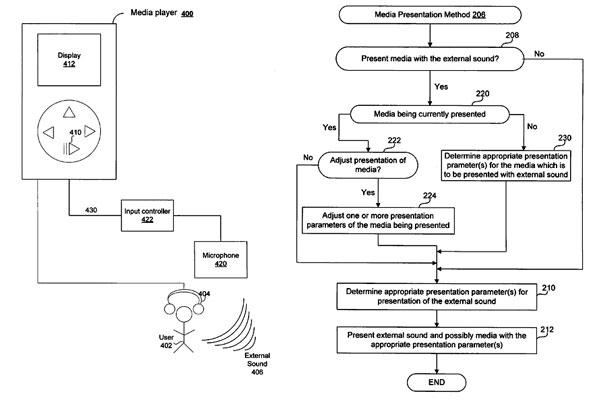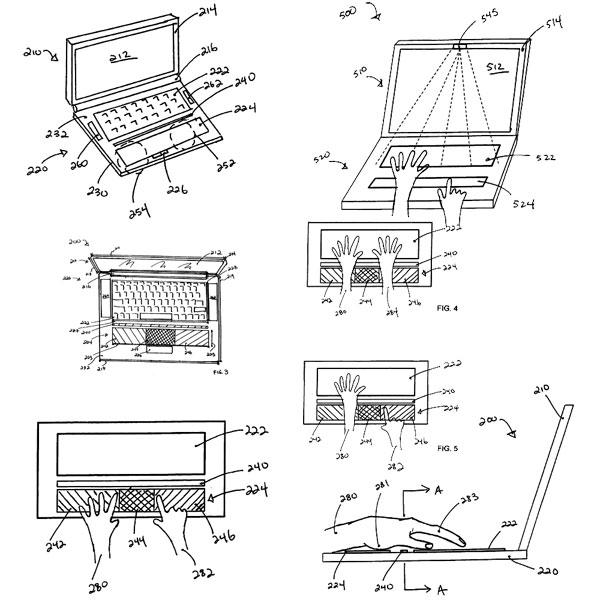Apple files for external audio blending, wide touchpad patents
Apple Inc. is looking to patent a software technique that would give iPod listeners access to critical external audio sounds — such as airline announcements — without having to remove their earbuds or pause their music. Separately, the company has also filed for continuation patent on a wide notebook touchpad that incorporates advanced touch control features.
The first filing, titled "presentation of audible media in accommodation with external sound," notes that external sounds — such as traffic and street noise — is typically reduced or blocked when a user is listening to audio content on their iPod or iPhone.
However, Apple claims that such external sound can be presented to users via the same interface, channel, or audio-output device used to present music or video sound tracks through a blending technique.
"This allows the user to use the headphones to listen, for example, to an announcement being made by the pilot, converse with flight attendants or other passengers without having to take the headphones off," the company wrote in the filing. "In addition, the media player can automatically resume the presentation of the media upon request (e.g., by pressing the pause again). It will be appreciated that external sound and digitally stored audible media (e.g., music files) can be combined (or blended) and presented to the user via the headphones in accordance with user input or various other programmable criteria."
Apple added that the media player can also store external sound as digital data and present it to the user with various play-back functions (e.g., pause, forward, backward, skip) that digital media players normally provide in connection with presentation of digital media. As such, users can configure the media player to effectively store the external sound while media is being presented to them. The user can later listen to the stored external sound when it is convenient. In addition, the use can conveniently go over the stored external sound with play-back functionality similar to that provided by digital media players.
The February 7, 2006 filing is credited to Apple employees Michael Lee and John Arthur.
Wide touchpad on a portable computer
In its second filing, which is presented as a continuation of an earlier patent on the same subject, Apple describes a notebook computer where the touchpad extends substantially into the palm rests areas of the base assembly.
"The wide touchpad may be a cursor control device having the capabilities of conventional computer mouse devices, such as the ability to point, drag, tap, and double tap objects on a graphical user interface, as well as more general purposes such as scrolling, panning, zooming, and rotating images on display screen," the filing states. "The wide touchpad extends into the areas on the surface of the base assembly that are normally reserved for palm rest areas (e.g., flat areas on the surface of the base assembly that support a user's palms and/or wrists while typing)."
Apple also says "the wide touchpad can filter multiple contact patches in order to accept a particular contact patch in one area of the touchpad while rejecting a second contact patch elsewhere on the wide touchpad. In one embodiment, a sensor is disposed between the keyboard and touchpad. The sensor defines a planar sensing region extending upwards from the top surface of the base assembly. The sensor detects a user's hand that may be resting on the base assembly with a palm portion making contact with a portion of the wide touchpad and the fingers extending toward keyboard."
When this detection is made, any contact made with a corresponding portion of the touchpad is rejected, having been interpreted as unintentional contact by the user, according to the filing. Alternatively, detection of fingers extending toward the keyboard may be evaluated as one of many factors used to decide whether and what significance to accord to contact with the touchpad.
"For example, other factors may include the profile of the contact with the touchpad, the level of keyboard activity at the time of contact, etc," Apple wrote. "In this way, the touchpad may effectively serve as a palm rest (e.g., the user may intentionally rest one or more palm or other part of a hand or arm on a portion of the touchpad, which is recognized as an unintentional input) in addition to a functional touchpad when an input is interpreted as being an intentional contact by the user."
The March 30, 2007 filing is credited to Apple interface designers Steve Hotelling, Chris Ligtenberg, Duncan Kerr, Bartley Andre, Joshua Strickon, Brian Huppi, Imran Chaudhri, Greg Christie, and Bas Ording.
 Prince McLean
Prince McLean












 Malcolm Owen
Malcolm Owen
 William Gallagher and Mike Wuerthele
William Gallagher and Mike Wuerthele
 Christine McKee
Christine McKee
 William Gallagher
William Gallagher

 Marko Zivkovic
Marko Zivkovic









